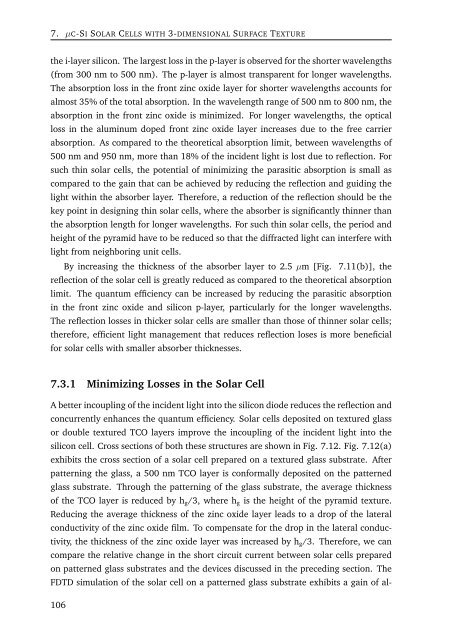Rahul Dewan - Jacobs University
Rahul Dewan - Jacobs University
Rahul Dewan - Jacobs University
You also want an ePaper? Increase the reach of your titles
YUMPU automatically turns print PDFs into web optimized ePapers that Google loves.
7. µC-SI SOLAR CELLS WITH 3-DIMENSIONAL SURFACE TEXTURE<br />
the i-layer silicon. The largest loss in the p-layer is observed for the shorter wavelengths<br />
(from 300 nm to 500 nm). The p-layer is almost transparent for longer wavelengths.<br />
The absorption loss in the front zinc oxide layer for shorter wavelengths accounts for<br />
almost 35% of the total absorption. In the wavelength range of 500 nm to 800 nm, the<br />
absorption in the front zinc oxide is minimized. For longer wavelengths, the optical<br />
loss in the aluminum doped front zinc oxide layer increases due to the free carrier<br />
absorption. As compared to the theoretical absorption limit, between wavelengths of<br />
500 nm and 950 nm, more than 18% of the incident light is lost due to reflection. For<br />
such thin solar cells, the potential of minimizing the parasitic absorption is small as<br />
compared to the gain that can be achieved by reducing the reflection and guiding the<br />
light within the absorber layer. Therefore, a reduction of the reflection should be the<br />
key point in designing thin solar cells, where the absorber is significantly thinner than<br />
the absorption length for longer wavelengths. For such thin solar cells, the period and<br />
height of the pyramid have to be reduced so that the diffracted light can interfere with<br />
light from neighboring unit cells.<br />
By increasing the thickness of the absorber layer to 2.5 µm [Fig. 7.11(b)], the<br />
reflection of the solar cell is greatly reduced as compared to the theoretical absorption<br />
limit. The quantum efficiency can be increased by reducing the parasitic absorption<br />
in the front zinc oxide and silicon p-layer, particularly for the longer wavelengths.<br />
The reflection losses in thicker solar cells are smaller than those of thinner solar cells;<br />
therefore, efficient light management that reduces reflection loses is more beneficial<br />
for solar cells with smaller absorber thicknesses.<br />
7.3.1 Minimizing Losses in the Solar Cell<br />
A better incoupling of the incident light into the silicon diode reduces the reflection and<br />
concurrently enhances the quantum efficiency. Solar cells deposited on textured glass<br />
or double textured TCO layers improve the incoupling of the incident light into the<br />
silicon cell. Cross sections of both these structures are shown in Fig. 7.12. Fig. 7.12(a)<br />
exhibits the cross section of a solar cell prepared on a textured glass substrate. After<br />
patterning the glass, a 500 nm TCO layer is conformally deposited on the patterned<br />
glass substrate. Through the patterning of the glass substrate, the average thickness<br />
of the TCO layer is reduced by h g /3, where h g is the height of the pyramid texture.<br />
Reducing the average thickness of the zinc oxide layer leads to a drop of the lateral<br />
conductivity of the zinc oxide film. To compensate for the drop in the lateral conductivity,<br />
the thickness of the zinc oxide layer was increased by h g /3. Therefore, we can<br />
compare the relative change in the short circuit current between solar cells prepared<br />
on patterned glass substrates and the devices discussed in the preceding section. The<br />
FDTD simulation of the solar cell on a patterned glass substrate exhibits a gain of al-<br />
106

















